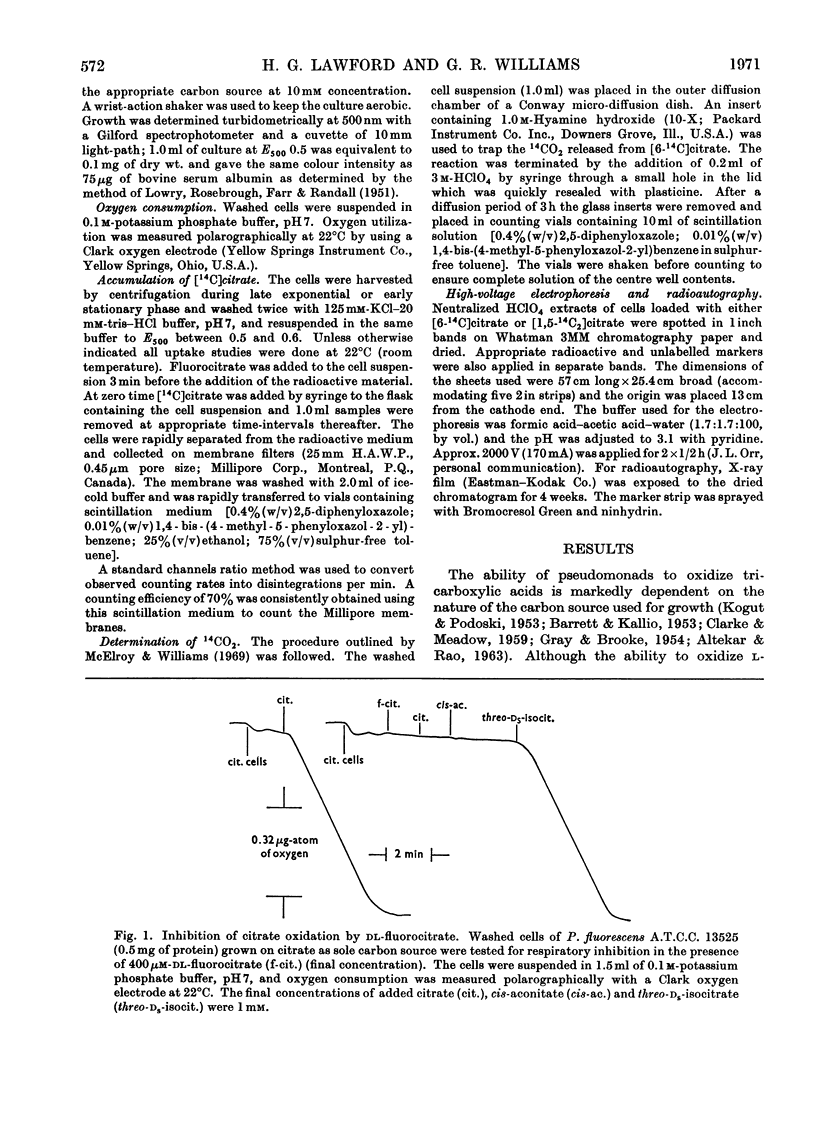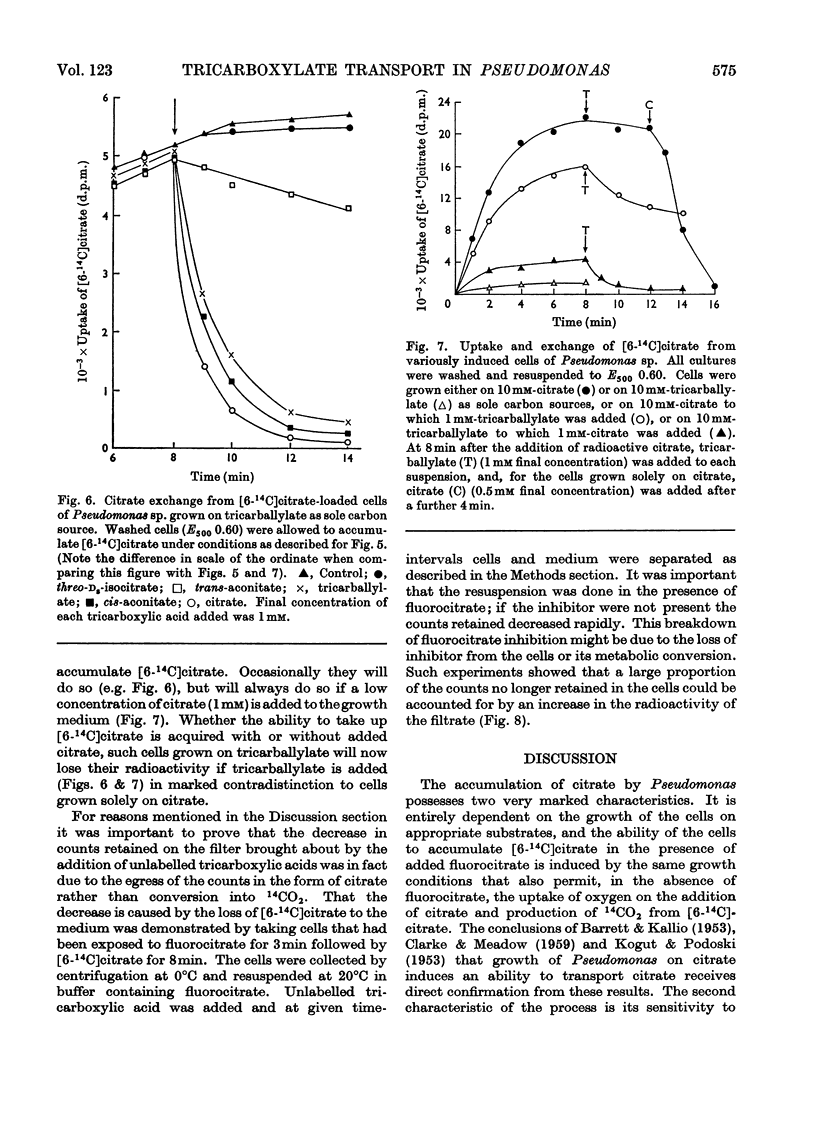Abstract
When cells of Pseudomonas are grown on citrate as the sole carbon source they oxidize citrate and isocitrate rapidly. Fluorocitrate inhibits the oxidation of citrate. Fluorocitrate-treated cells accumulate [6-14C]citrate, as shown by a rapid Millipore-filtration technique. In the absence of fluorocitrate most of the [6-14C]-citrate is lost in the form of 14CO2. The isolation of a pseudomonad characterized by its ability to grow on tricarballylate as a sole carbon source has facilitated the study of the tricarboxylate-carrier specificity. Cells grown on citrate will exchange radioactive citrate for unlabelled citrate or isocitrate but not for cis-aconitate, trans-aconitate or tricarballylate. Cells grown on tricarballylate will exchange radioactive citrate for unlabelled citrate, cis-aconitate or tricarballylate, but not for isocitrate or trans-aconitate. The properties of the exchange system involved are compared with those of the related system in mitochondria.
Full text
PDF






Selected References
These references are in PubMed. This may not be the complete list of references from this article.
- ALTEKAR W. W., RAO M. R. MICROBIOLOGICAL DISSIMILATION OF TRICARBALLYLATE AND TRANS-ACONITATE. J Bacteriol. 1963 Mar;85:604–613. doi: 10.1128/jb.85.3.604-613.1963. [DOI] [PMC free article] [PubMed] [Google Scholar]
- BARRETT J. T., KALLIO R. E. Terminal respiration in Pseudomonas fluorescens: component enzymes of the tricarboxylic acid cycle. J Bacteriol. 1953 Nov;66(5):517–525. doi: 10.1128/jb.66.5.517-525.1953. [DOI] [PMC free article] [PubMed] [Google Scholar]
- CLARKE P. H., MEADOW P. M. Evidence for the occurrence of Permeases for tricarboxylic acid cycle intermediates in Pseudomonas aeruginosa. J Gen Microbiol. 1959 Feb;20(1):144–155. doi: 10.1099/00221287-20-1-144. [DOI] [PubMed] [Google Scholar]
- COHEN G. N., MONOD J. Bacterial permeases. Bacteriol Rev. 1957 Sep;21(3):169–194. doi: 10.1128/br.21.3.169-194.1957. [DOI] [PMC free article] [PubMed] [Google Scholar]
- Harris E. J., Manger J. R. Intramitochondrial substrate concentration as a factor controlling metabolism. The role of interanion competition. Biochem J. 1968 Sep;109(2):239–246. doi: 10.1042/bj1090239. [DOI] [PMC free article] [PubMed] [Google Scholar]
- KOGUT M., PODOSKI E. P. Oxidative pathways in a fluorescent Pseudomonas. Biochem J. 1953 Dec;55(5):800–811. doi: 10.1042/bj0550800. [DOI] [PMC free article] [PubMed] [Google Scholar]
- Kay W. W., Kornberg H. L. Genetic control of the uptake of C(4)-dicarboxylic acids by Escherichia coli. FEBS Lett. 1969 Apr;3(2):93–96. doi: 10.1016/0014-5793(69)80105-5. [DOI] [PubMed] [Google Scholar]
- Kirk K., Goldman P. Fluorocitric acid: selective microbial degradation of the inhibitory isomer. Biochem J. 1970 Apr;117(2):409–410. doi: 10.1042/bj1170409. [DOI] [PMC free article] [PubMed] [Google Scholar]
- LOWRY O. H., ROSEBROUGH N. J., FARR A. L., RANDALL R. J. Protein measurement with the Folin phenol reagent. J Biol Chem. 1951 Nov;193(1):265–275. [PubMed] [Google Scholar]
- SISTROM W. R. On the physical state of the intracellularly accumulates substrates of beta-galactoside-permease in Escherichia coli. Biochim Biophys Acta. 1958 Sep;29(3):579–587. doi: 10.1016/0006-3002(58)90015-5. [DOI] [PubMed] [Google Scholar]
- Villarreal-Moguel E. I., Ruiz-Herrera J. Induction and properties of the citrate transport system in Aerobacter aerogenes. J Bacteriol. 1969 May;98(2):552–558. doi: 10.1128/jb.98.2.552-558.1969. [DOI] [PMC free article] [PubMed] [Google Scholar]
- Winkler H. H., Wilson T. H. The role of energy coupling in the transport of beta-galactosides by Escherichia coli. J Biol Chem. 1966 May 25;241(10):2200–2211. [PubMed] [Google Scholar]


